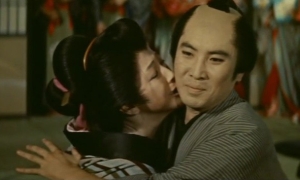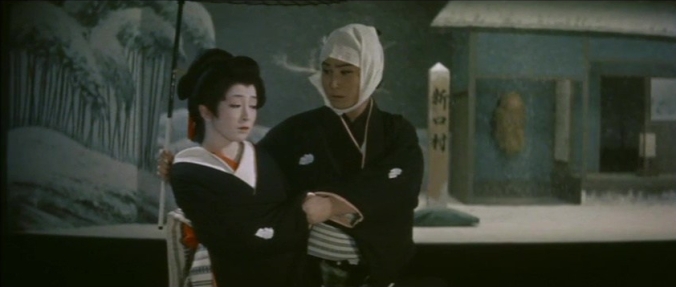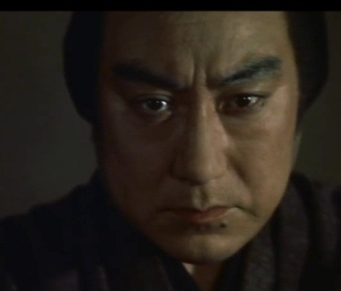
Ineko Arima and Kinnosuke Nakamura
Chubei has been adopted into a family to learn the business and eventually marry the daughter. Dragged by a friend/customer to the pleasure quarter, he is trapped reluctantly into spending his first night with a woman, the popular and lovely courtesan Umegawa. They fall in love, and when a rich man tries to buy Umegawa, Chubei steals the money from his business clients to outbid the businessman. The crime is discovered and they run away together but are soon captured and returned to Osaka, where she is returned to the brothel and he is to be beheaded.
This is essentially one of Chikamatsu’s most popular bunraku plays, The Courier for Hell, which oddly seems not to have been previously adapted to the screen.* The modern addition is that we also meet Chikamatsu, who overhears the characters in tea houses and in the brothel where he often visits, apparently to drink and write. This allows him to overhear lines he quickly writes down to remember, presumably famous lines from the play that non-Japanese audiences will not recognize. Thus, in structure, it is simply “How I came to write . . . .” But it also provides a commentary on the transformations of real life into art, primarily in the way Chikamatsu changes the ending of the couple’s story.
Given the ending, it appears that somewhere along the line there was an intention to contrast reality and art, but if so, that got lost in the process. Part of this is a result of the studio color and sets that seem almost as artificial as the stage sets we eventually see.
The other problem is Kinnosuke Nakamura’s performance as Chubei. He so overplays the naivete and innocence that he seems about eleven years old. It is possible to eventually explain this as a decision to suggest the stereotypical aspect of the role and at times he seems to be like a bunraku puppet in real life. Ineko Arima** as Umegawa shares much of this artificiality, but it seems more realistic from a popular courtesan whose typical interactions with others are necessarily artificial.
Then again, it may have been intentional to suggest that the characters are trapped in a fated, pre-written situation — puppets, so to speak, but puppets of their emotions rather than of any external manipulators.
Ironically, the most relaxed and natural performance is from Chikamatsu, played by Chiezo Kataoka, who was one of the great exponents of the traditional, stoic, inexpressive chanbara hero.
As directed by Tomu Uchida, it is one of the purest examples of classical Japanese film-making during the time of conversion to color and wide screen. The camera is rarely immobile, but it always stays at a distance, so much so that I began to count close-ups — three. The shots tend not to be from the typical low position, viewing from many heights but without high overheads. Most conversations are in two-shot without any crosscutting or reaction shots. Thus, it lies clearly in the Mizoguchi tradition, though without the careful compositions one associates with Mizoguchi’s films and often opting for pretty rather than beautiful. Its transition from ‘reality’ to ‘theatrical’ is also a common feature of the era, though here the theatrical is saved for the conclusion and in fact duplicates famous scenes the audience may already know.
At the same time, it is strangely moving. The distancing of the camera and the performances begin to pay off when we reach the emotional climax, which is a dance sequence with a stage set, apparently drawn from the play itself.  But unlike the play, reality at last intrudes and the couple are captured and returned to Osaka. The movie then concludes with Umegawa merging into her puppet in the performance of the play, as Chikamatsu watches from the rear of the house, with one of the great enigmatic expressions of film history. When he should be happy at the play’s great success,
But unlike the play, reality at last intrudes and the couple are captured and returned to Osaka. The movie then concludes with Umegawa merging into her puppet in the performance of the play, as Chikamatsu watches from the rear of the house, with one of the great enigmatic expressions of film history. When he should be happy at the play’s great success,  he seems frustrated, even angry about what he is watching. Unfortunately, the sub-titler, as so often happens, decides we don’t need to know what the performance itself is saying, doubly frustrating because the scene we see includes a character we have not seen in the movie (presumably Chubei’s father).
he seems frustrated, even angry about what he is watching. Unfortunately, the sub-titler, as so often happens, decides we don’t need to know what the performance itself is saying, doubly frustrating because the scene we see includes a character we have not seen in the movie (presumably Chubei’s father).
I don’t think this is an unknown classic; the director’s decision to hang halfway between the apparent realism of Mizoguchi’s Chikamatsu film and the artificiality of Shinoda’s makes the film seem uncommitted, at least to me. On the other hand, it does hold the attention far more than it has any right to do so. You will not regret watching it.
* Mizoguchi’s Chikamatsu monogatari and Shinoda’s later Double Suicide are based on two other, different, Chikamatsu plays. There is also a later film of a bunraku performance of this particular play. Given Chikamatsu’s position as the “Japanese Shakespeare,” it is remarkable how rarely he has been adapted to the screen.
** While watching, I found myself wondering who this lovely doll-like actress could be, since I would have sworn I had never seen her before. It turns out I have — Black River, Night Drum, three late Ozu films, and Zero Focus attest to her range and her transformative ability.



Pingback: Lost Paradise / Shitsurakuen (1997) | Japanonfilm
Pingback: Dolls | Japanonfilm